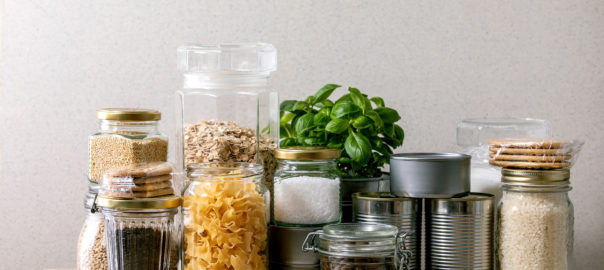Pandemic, natural disasters, and terrorist attacks often come with little to no warning. To weather the storm, stocking up NOW would be a wise idea.
Some food, if properly sealed and stored correctly, can last for years. According to ready.gov, it is important to stock canned foods, dry mixes, and other staples that do not require refrigeration, cooking, water, or special preparation.
I’ve listed below necessary items for your emergency supply plan -- food, water, and other essentials -- to help you build your survival kit.
Preparing an emergency food supply
As we all know, global crises like COVID-19 can easily disrupt the food supply. Planning to have at least a 14 day supply of food can help you build an emergency stockpile in your home.
Keep food that:
- Has a long storage life
- Requires little or no cooking, water, or refrigeration
- Meets the needs of family members who are on special diets
- Meets pets’ needs
- Are not very salty or spicy, as these foods increase the need for drinking water, which may be in short supply
- Have no artificial ingredients, MSG, unpronounceable chemical names, etc.
Note: Read the labels. Just because this is emergency planning doesn’t mean that you want to buy those kits with all the cruddy ingredients in it!
Recommended emergency food items
It should be understood that you only want to store what your family will eat. For example, don’t buy canned lima beans if no one eats them. Here’s what you should store in your pantry:
- Ready-to-eat canned meats, fruits, vegetables
- Protein or fruit bars
- Dry cereal or granola
- Nut or seed butter
- Dried fruit
- Canned juices
- Non-perishable milk
- High-energy foods
- Food for infants (if you have one in your home)
- Comfort/stress foods
How to store emergency food
Certain storage conditions may enhance the shelf life of foods. The ideal location is a cool, dry, and dark place. The most suitable temperature is 40° to 70°F.
- Store foods away from ranges or refrigerator exhausts.
- Store food away from petroleum products. Some food products absorb their smell.
- Items stored in boxes or in paper cartons will keep longer if they are heavily wrapped or stored in waterproof, airtight containers.
- If you have extra space in your freezer, fill it with bags of water. This can help keep food cold if the power goes out. If you need to leave, it will provide ice for the trip.
Also read Guide To Freezing Food: What You Can And Can’t Put In The Freezer to learn more on how long you can keep food in the freezer and food safety during power outages.
Essential tools and items for food preparation
Having the following items available will help you to prepare meals safely:
- Cooking utensils
- Knives, forks, and spoons
- Paper plates, cups, and towels
- A manual can- and bottle-opener
- Heavy-duty aluminum foil
- Wax paper and/or parchment paper
- Propane gas or charcoal grill; camp stove
- Extra water to be able to rehydrate dehydrated food
- Fuel for cooking, such as charcoal
Preparing an emergency water supply
Water can be a critical item, especially for those on a well without power. Do not store water in the plastic containers they come in (those leaks — ask me how I know that — one soggy closet floor later). Use an aquatainer, they’re made for longer-term water storage.
- Requirements are 1 gallon of water per day for each person and each pet for cooking and drinking. Also, store an additional gallon per person for sanitary needs.
- Store at least a 3-day supply of water for each person and each pet. Try to store a 2-week supply if possible.
- Observe the expiration date for store-bought water
- Store a bottle of unscented liquid household chlorine bleach to disinfect your water and to use it for general cleaning and sanitizing.
Note: As much as possible, do not drink liquid that can dehydrate the body; i.e., caffeine, soda, and alcohol.
Recommended items for emergency supply kit
Aside from the food, water, and other items for food preparation, here are other recommended items to include in your family’s emergency supply kit:
- Battery-powered or hand-crank radio and a NOAA Weather Radio with tone alert
- Flashlight
- First aid kit
- Extra batteries
- Whistle (to signal for help)
- Dust mask (to help filter contaminated air)
- Plastic sheeting and duct tape (to shelter in place)
- Moist towelettes, garbage bags and plastic ties (for personal sanitation)
- Wrench or pliers (to turn off utilities)
- Local maps
- Cell phone with chargers and a backup battery
- Glow stick for pets’ collar (so you don’t trip over them at night)
- List of important addresses and phone numbers
- Gas refill (always refill your tank if you are at ½)
Join my Exclusive Community: The Kitchen Table!
- Access to masterclasses on gut health, migraine management, and preparedness pantry.
- Library with all my ebooks covering holistic health topics.
- Engaging monthly book club discussions.
- Specialized modules to enhance your wellness journey.
- Interactive calls for personalized guidance.
- Comprehensive community support
Sources:


